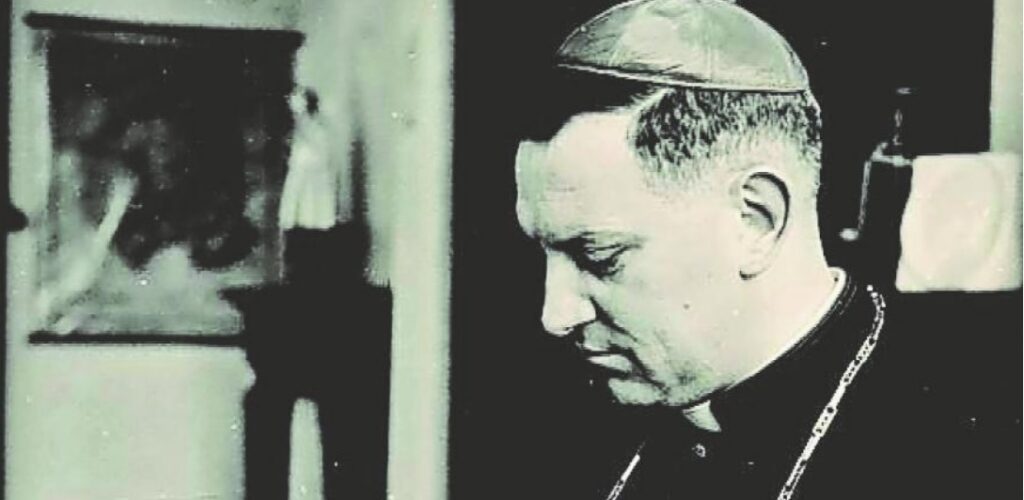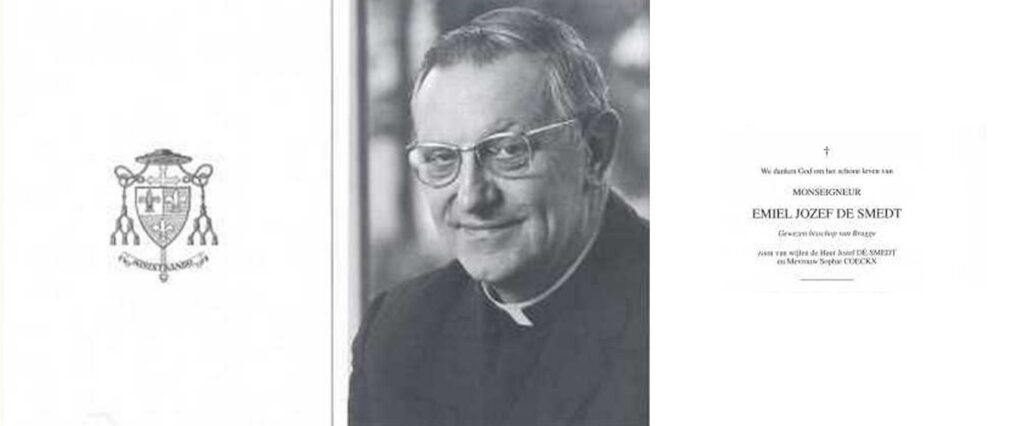By Ferdinand Boischot
On May 19, 1966, the Belgian bishops, led by Cardinal Suenens and Bishop De Smedt, blew up the Catholic Church in Flanders
From the beginning of the 1960s there was a huge crisis in Belgium: the Dutch-speaking Flemings, who had been neglected and discriminated against since the founding of Belgium (1830), fought harder than ever for their self-determination and equality, the coal and steel region in the Borinage collapsed, the state groaned beneath enormous financial burdens, the Belgian establishment was frustrated by the rapid and unsuccessful decolonization of the Congo, the liberals and socialists on the one hand and the Christian Democrats on the other, eyed each other suspiciously after the "school fight" (1954), in the university town of Leuven things were seething among the students, and a military coup threatened. As part of a local laissez-aller under the cloak of Vatican II, all Christian leadership evaporated. During strikes in the Limburg coal mines in 1966, the gendarmerie shot two young men (Zwartberg crisis) and the more neutral army had to be deployed.
The Belgian bishops were well informed. They were closely associated with the Christian Democrat leadership and ruled over a wide range of Catholic schools, hospitals, unions and charities and senior citizens' associations.
The Great Protagonist
Bishop De Smedt was the main protagonist here. Vice-rector of the Catholic University of Leuven since 1959 was the “very young” Guido Maertens (then 29 years old) from Bruges, who was ordained a priest by Bishop De Smedt and, at the age of 30, had been appointed monsignor and “prelate of His Holiness” like a meteor.
The heated situation in Louvain was well known, as was the dislike of Flemish students towards the aloof Brussels Cardinal Suenens.
Despite this, or probably precisely because of this, the Belgian bishops' conference published its notorious mandate on May 19, 1966, which immediately triggered civil war-like conditions in Leuven. The gendarmerie reacted exaggeratedly. Great destruction ensued, and centralized Belgium fell apart. The university and its institutions were split head over heels to the point of criminality (an impossible division of books in the library). The government fell. And suddenly a quarter of all believers disappeared from the churches.
The bishops immediately went into hiding.
Without the disturbing looks of critical believers, the Christian Democrat-led iconoclasm and liturgical killing spree could be carried out smoothly.
Bishop De Smedt followed suit with perfidious intelligence on February 2, 1968: In an interview (of course published immediately and widely) he said that "at that time (1966) he had made a serious mistake by sticking to the unity of two wings (of the Catholic University Louvain).
As a result, no Flemish Catholics went to church, but the relationship with the French-speaking bishops in the Belgian bishops' conference was strained for the next 20 years.
The isolation of the Christian-democratic-modernist, de facto former Catholic Church in northern Belgium, without disturbing observers from outside, was perfect.
The Diocese of Bruges as a laboratory and hotspot
The Bruges diocese was here, together with Leuven, the Wagenburg alias laboratory and hotspot for a particularistic North Belgian Christian Democratic morality with exploding homosexuality and pedosexuality.
De Smedt never published much: before the Council and as a prime example of an evangelizing bishop, he published a small booklet on Catholic “Evangelization in the Neighborhood”, which was also translated into French and Spanish.
After the Council, he produced a booklet on “The Priesthood of All Believers”, which was significantly published abroad (France) and remained unknown in Belgium (easily understandable after the events of 1966-1968) because the context was too incoherent and was obviously hypocritical.
Existing biographical notes on the post-1966 period are very sparse, even remarkably sparse. In the diocese of Bruges, the vast majority of priests were ordained and the seminary there was the northern Belgian "cadre factory".
Here Roger Vangheluwe (later pedosexual Bishop) became Dean and Professor at the Major Seminary; here Frans Lefevre, a friend of Danneels and editor of the infamous Roeach series of books on religious education, was ordained and also a professor at the seminary; here Johan Bonny (later homophilic bishop of Antwerp) was ordained a priest. Auxiliary Bishop Paul Lanneau, Danneels' aide and sentenced to prison for covering up pedophilia, was co-consecrated by De Smedt.
The Bruges Major Seminary became a super-social hotspot, although this 'social' does not (of course) refer to the Flemish aspirations.
In 1979, the booklet "As man and woman he created them " with the subtitle "Ethical Orientations in Sex Education" was published by the publishing house Lannoo (Tielt), which is traditionally associated with the diocese, under the authorship of De Smedt.
It's written in a boring way, in the style of the bombast of northern Belgian modernism. Already in the foreword by Bishop De Smedt it is expressly said: "... because many young people have difficulties and questions, and I want to help them..." (sic).
Just four pages with some thoughts on Christian education, then a great many pages to: "It's about the happiness of the people" ("sinful man and the forgiving love" - this topos was literally used by Cardinal Danneels in the Vangheluwe scandal; "Danneels-tapes"), then the jump is made to: "Development of ethical action and feeling" (typical for the University of Louvaine 1970-2020). Finally, the central piece follows: “Love and Sexuality”. This is the full program of the Danneels Epoch 1983-2009.
It is significant that the first part on sexuality in general (5.5 pages) is immediately followed by the part on homosexuality (also 5.5 pages).
Nota bene: Homosexuality had not been criminalized in Belgium until eight years earlier (although this action was led in large part by a “worker priest”).
It is only in the last chapter “Growing in Love” that there are five pages about marriage and parallel to that also about renunciation (the word celibacy is used twice, the word council once, and the word monastery twice).
As stated at the end of the preface, the booklet is composed of papers from a study group set up by Bishop De Smedt.
Linguistically smoothed out by Mark Vandevoorde, later spokesman and speechwriter for senior Christian Democrat politicians, also well acquainted with Vangheluwe and a seminary professor, plus Guido Maertens (former Vice-Rector of Louvaine and "ethicist"), a Christian Democrat sociologist (WD) and four professors from the Major Seminary in Bruges, apart from Maertens (later at KULAK in Kortrijk) and the sociologist, will all continue to work seamlessly under Vangheluwe.
They are all "rewarded" with induction into the Chapter of St. Salvator's Cathedral in Bruges.
The booklet is not very attractive from the outside (in my case "3rd impression").
The new sexual morality
At the same time, a slimmed-down version was printed for young people as a large, colorful brochure on glossy paper (52 pages, 50,000 copies of the 1st edition). Lots of large format photos of brick walls and a sandy beach, a bicycle handlebar with a bell, door handles, traffic signs and similar nonsense.
The title is "Ontmoeten" "to meet", with small subtitles "a letter to young people and their companions about relationship building, love and sexuality".
The chapter on homosexuality has been removed, and an extra section on masturbation and sinful thoughts have been added, and that too is spoken in flat language...
The whole body of thought of the Danneels and Vangheluwe epoch with their sex fixation and the complete loss of faithful Catholic morality is already there. The professor protagonists of the Danneels and Vangheluwe eras are also already present.
As said, almost all of them can be found in the list of canons of the cathedral chapter of St. Salvatore in Bruges.
Even now (2022) Vangheluwe's "companions" and cronies are sitting there in large numbers.
The biographical notes on Bishop De Smedt then become fewer and fewer.
He wrote another thin, large format pamphlet about Europe aka the EU, on pink and black porous paper and with no Christian content.
In 1984 De Smedt retired; he was succeeded by Roger Vangheluwe.
De Smedt withdrew to a convent in Bruges and no longer appeared in public.
In 1985, during the visit of Pope John Paul II, he stayed in the background. Pretty strange for one of the most crucial figures of Vatican II.
Apparently, Bishop De Smedt's activities were viewed very critically in Rome at the time.
It is said that De Smedt suffered from dementia at a fairly early age (75 years old). He died in 1994 at the age of 85.
Nothing is known of a reaction by bishop emeritus De Smedt to the article about the “establishment of a working group to promote the interests of pedophiles in the church” (sic) in 1985 in the Church newspaper “Kerk en Leven” (notabene printed by the diocesan publisher in Bruges).
Neither De Smedt nor his “ethical study group” are aware of a reaction to the “religious instruction book” Roeach3 with pedophile texts and illustrations (1992).
It would be another 20 years before the authors and staff were either dead or retired.
The mafia-like wagon company of the Bruges diocese held out for a very long time (until 2017).
Conclusion
Under Bishop Emiel Jozef De Smedt, the homo- and pedophile impregnation of the diocese of Bruges was initiated in terms of personnel and content, and this was probably in close connection with the ideas of the Second Vatican Council.
It continued seamlessly under his successors Vangheluwe and De Kesel, and spilled over to the whole of northern Belgium.
Terra devastata - scorched earth.
References:
- MGR. EJ De Smedt: Man en vrouw schep Hij hen : ethical orientations in de seksuele opvoeding , Tielt , 1979
- MGR. E.J. De Smedt: "Ontmoeten" : a brief aan jongeren en hun daughters over relational, delivered in seksualiteit" , Tielt-Amsterdam 1979
- t'Pallieterke, No. 21, May 26, 1966
- Trans: Tancred vekron99@hotmail.com
- AMDG






